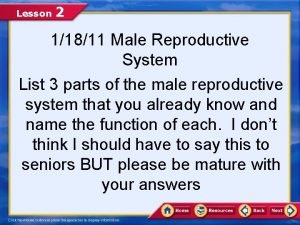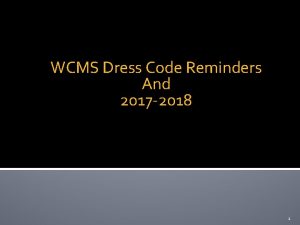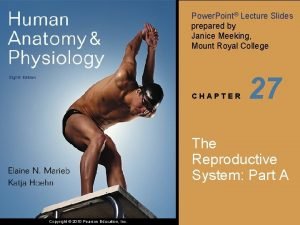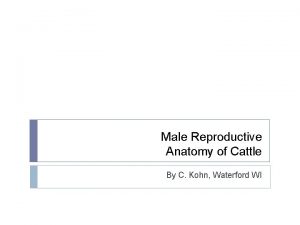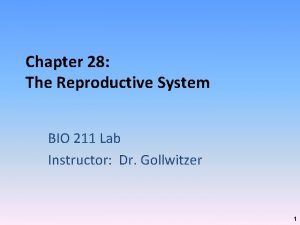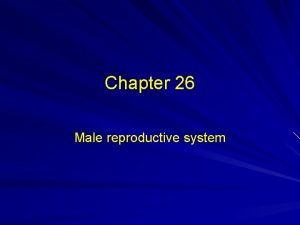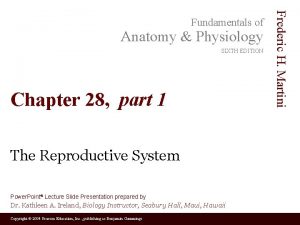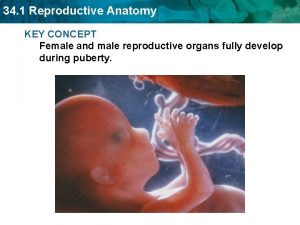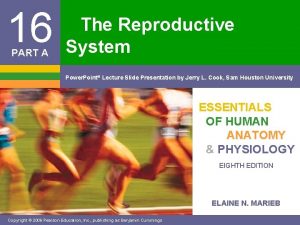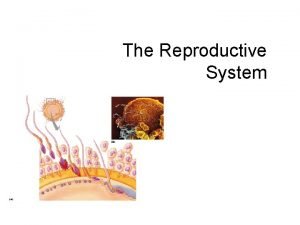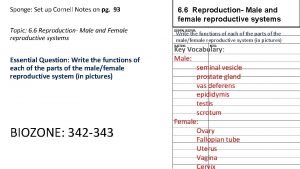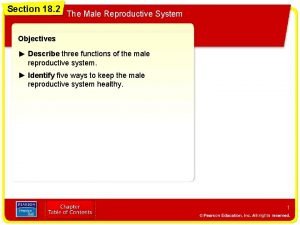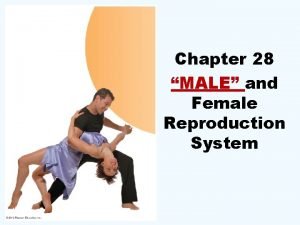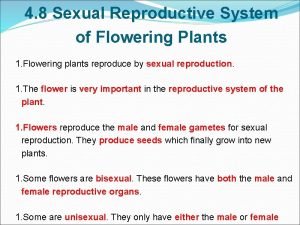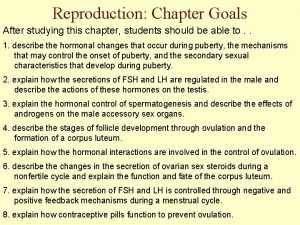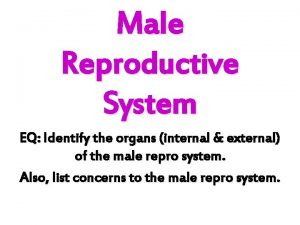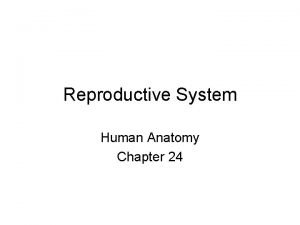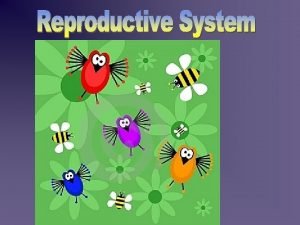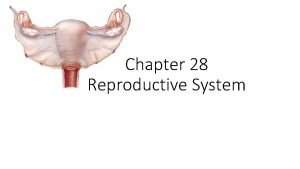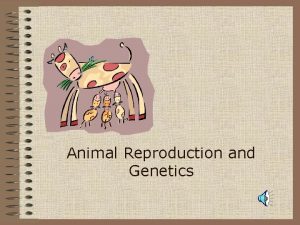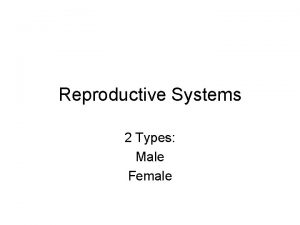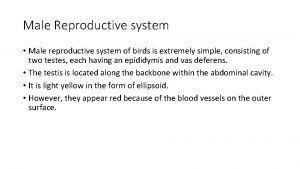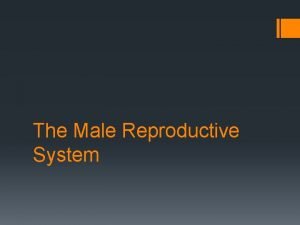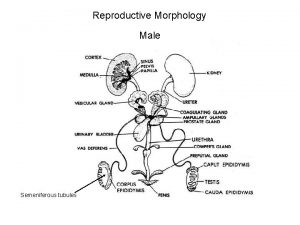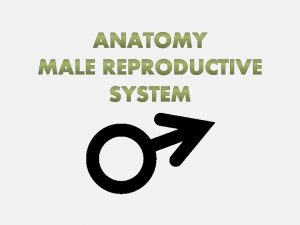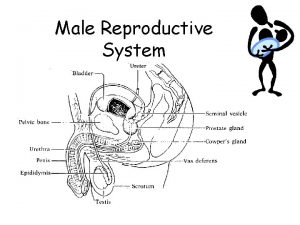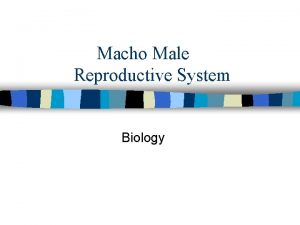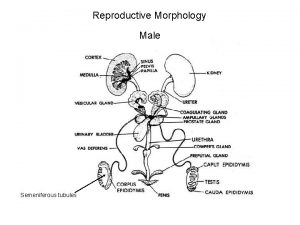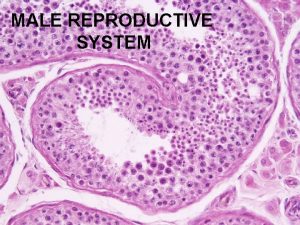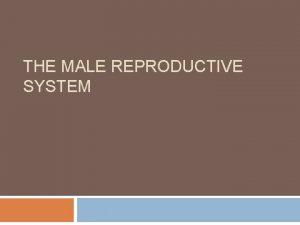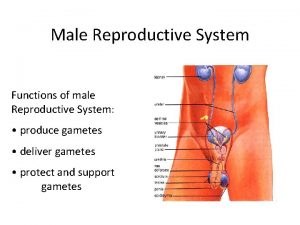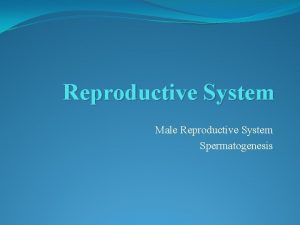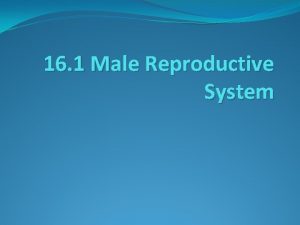Male Reproductive Systems Unit 8 Lesson 2 Reminders
















































- Slides: 48

Male Reproductive Systems Unit 8 Lesson 2

Reminders • You can always: • Re-due assignments • Re-take tests • Turn in missing assignment without penalties Getting Started • PICK UP: • New Male Reproduction Packet Objectives • Identify parts and purpose of the male reproductive system • Describe problems that can occur with the male reproductive system • Explain how to properly care for the male reproductive system

Human Reproduction • The reproductive systems are different in males and females. • Each system has different parts and functions. • Each system has different potential problems and care.


Male Reproductive System

Male Reproductive System • Males begin to produce sperm at puberty. • Sperm is the male reproductive sex cells. • Sperm cells are the smallest cells in the human body.

Male Reproductive System • The job of the sperms cells it to find the egg cell in the female and fertilize it. • Fertilization is the joining of the sperm and egg cells. • This means that the 23 chromosomes from dad combine with the 23 chromosomes from mom to create 46 chromosomes in a new embryo.

Male Reproductive System • Most men will produce 100 million sperm cells in each testes per day. • Why do men produce so many sperm cells? • Many sperm cells are misshapen or non-functioning.

Male Reproductive System • Most sperm cells will die on their journey. • Sperm must swim 4 inches against a current. • This is an equivalent to swimming 24 miles. • Out of the millions of sperm cell, only 100 sperm cells will actually make it to the egg.

Male Reproductive System • Sperm cells are unique in their shape and function. • Sperm cells have a head, midsection, and tail. • The head carries the genetic codes from the dad. • Mid Section carries nutrients for energy • The tail (flagellum) helps move the sperm through fluid. • The sperm is the only cell with a tail. Tail: Flagellum Mid Section with Mitochondria Head 23 Chromosomes Nucleus

Male Reproductive System • Sperm cells are created in the testes. • Testes or testicles are the two small glands that produce sperm. • Inside the testes, special cells divide so that each sperm cell contains half of the man’s chromosomes.

Male Reproductive System 46 Chromosomes X and Y chromosome • Remember from the Life Cycle unit, sperm cells will contain either the X chromosome or the Y chromosome. • Depending on which sperm cell reaches the egg cell first will determine the gender of the baby. 92 chromosome X and y chromosome X and Y – 46 Chromosome X Y

Male Reproductive System • Testosterones is also created inside the testes. • Testosterone is the male sex hormone that is responsible for many changes that take place during puberty.

Male Reproductive System • Once the sperm cells are created they are stored in the epididymis where the sperm cells continue to mature and grow. • The epididymis sits on top of each testicle.

Male Reproductive System • The scrotum is a protective skin sac that holds the testes and regulates the temperature. • In order for sperm cells to survive, the testes must maintain a certain body temperature.

Male Reproductive System • Normal body temperature is 98. 6 degrees. • This is too warm for sperm production and survival. • This is why the testicles are on the outside of the male body.

Male Reproductive System • When a male becomes too hot the scrotum will relax and drop the testicles further away from the body to lower their temperature. • When a male becomes too cold, the scrotum will contract and pull the testicles closer the body to increase temperature.

Male Reproductive System • This is all done automatically by the body. • The male does not have conscious control of the movement of the scrotum.

Male Reproductive System • Each epididymis is connected to a vas deferens tube. • The Vas Deferens tube carries sperms cells from the epididymis to the seminal vesicles.

Male Reproductive System • The seminal vesicles, prostate gland, and the Cowper’s gland all add fluid to the sperm as it passes through from the vas deferens.

Male Reproductive System • These fluids are added to the sperm to help nourish and protect the sperm once it leaves the male body. • The combination of the sperm and these fluids is called semen.

Male Reproductive System • Once the semen leaves the vas deference tube it travels down the urethra. • The urethra is a tube inside the male penis. • The urethra has two functions in the male. 1. Carry semen out of the body 2. Carry urine out the human body

Male Reproductive System • The penis the external male sex organ. • In some cultures the foreskin is removed. • The removal of the foreskin is call circumcision.

Male Reproductive System • Inside the penis, there are empty chambers called the corpus cavernosum. • The corpus cavernosum are empty chambers inside the penis. • When a male becomes sexually aroused the chambers are filled with extra blood.

Male Reproductive System • The filling of the chambers causes the penis to elongate and become more ridged. • The elongating of the penis is called an erection.

Male Reproductive System • Sometimes a male can have an erection without being sexual aroused. • Because the male body is changing so rapidly during adolescences it is common for a male to have an erection without being sexually aroused. • This is completely normal and in most cases uncontrollable.

Male Reproductive System • During sexual arousal the male body prepares itself to release semen. • The release of the semen is called ejaculation. • When a male ejaculates, the semen is forced from the body through the tip of the penis.

Male Reproductive System • One ejaculation equals about 1 teaspoon of fluid • And it contains million of sperm cells.

Male Reproductive System • Like an erection, ejaculation usually takes place when sexually aroused. • But sometimes males (especially during puberty) will have nocturnal dreams. • A nocturnal dream is an uncontrolled ejaculation during sleep.

Male Reproductive System • A nocturnal dream occurs during deep sleep. • Sometimes while sleeping a male will spontaneously ejaculate. • Again, this is very common and normal for males during adolescences.

Male Reproductive Problems • It is important that males get regular medical checkups. • Checkups help men protect themselves and prevent future problems. • It is important that if a male has anyone of the following symptoms that they seek medical help immediately. • • Pain during urination Swelling or lump in the genital area Sores or irritated skin Pain in lower abdominal area

Male Reproductive Problems • Inguinal hernia is a weakness in the lower abdominal wall that allows a small loop of intestine to bulge through into the scrotum. • It is important that males get regular checkups so that hernias can be detected early. • Surgery is used to correct.

Reminders • You can always: • Re-due assignments • Re-take tests • Turn in missing assignment without penalties Getting Started • TAKE OUT: • New Male Reproduction Packet Objectives • Identify parts and purpose of the male reproductive system • Describe problems that can occur with the male reproductive system • Explain how to properly care for the male reproductive system

Male Reproductive Problems • An undescended testicle is a development defect in which the testicle has not dropped into the scrotum. • An undescended testicle can cause damage to the testicle by not allowing it to produce sperm. • Surgery is used to correct.

Male Reproductive Problems • Testicular torsion occurs when the testicle twists. • This causes the nerves and the blood vessels to pinch which causes swelling and pain. • Testicular torsion usually happens during athletic activity. • Immediate medical care is required to prevent damage to the testicle.

Male Reproductive Problems • The urethra runs right through the middle of the prostate. • When the prostate enlarges, it can cause frequent and slow urination. • This usually occurs with age. • There are some medications and surgery that can help.

Male Reproductive Problems • Jock itch is an infection of the skin by a fungus. • It often occurs when the scrotum and groin skin stays hot a moist. • The symptoms are red, itchy, irritated skin. • Jock itch can be prevented by keeping the area clean and dry. • Some over the counter creams or ointments help relieve irritation.

Male Reproductive Problems • A urinary tract infection is an infection of the urethra, bladder, ureters, and/or kidneys. • Symptoms include pain and burning during urination. • Sometimes the urine could be bloody. • Medical treatment is required to cure. • Antibiotics are used to treat.

Male Reproductive Problems • Testicular cancer is the uncontrolled growth of cells in the testes. • Testicular cancer usually does not cause pain therefore it is important to get regular check ups and do self exams. • Surgery and chemotherapy are used as treatment. • If left untreated, the cancer cells can spread to other parts of the body that can lead to death.

Testicular Exam • Place the index and middle fingers under the testicle with the thumbs placed on top. • Check for any swelling on the scrotal skin. • Examine each testicle with both hands. • Roll the testicle gently between the thumbs and fingers. • You shouldn't feel any pain when doing the exam.

Testicular Exam • Don't be alarmed if one testicle seems slightly larger than the other, that's normal. • Find the epididymis, the soft, tube like structure behind the testicle that stores the sperm. • Be careful not to mistake this structure for a suspicious lump.

Testicular Exam • Cancerous lumps usually are found on the sides of the testicle but can also show up on the front. • Lumps on or attached to the epididymis are not cancerous.

Testicular Exam • When conducting a Testicular Exam you are looking for any of the following: 1. Any enlargement of a testicle 2. A significant loss of size in one of the testicles 3. A feeling of heaviness in the scrotum 4. A dull ache in the lower abdomen or in the groin 5. A sudden collection of fluid in the scrotum 6. Pain or discomfort in a testicle or in the scrotum

Testicular Exam • If you have any of these symptoms; tell your parents and/or doctor. • Waiting and hoping is will go away will not fix anything. • When in doubt, get it checked out!

Care for the Male Body 1. Bathe regularly 2. Keep skin clean and dry 3. Always wear protective gear when playing sports 4. Get regular check ups and report any pain, swelling, tenderness, or lumps 5. Do regular testicular exams. 6. Abstain from sex before marriage to prevent the spread of sexually transmitted disease

Bladder Urethra Prostate Gland Penis Seminal Vesicles Epididymis Vas Deference Testicle

Quick Check 1. 2. 3. 4. 5. 6. 7. 8. ____ is the male sex cell. ____and ____ is produced in the testes. Sperm is stored in the ____ until needed for ejaculation. Name three glands that add fluid to sperm to make semen. The ____ controls the temperature of the testicles. In erection is caused by an increase of ___ into the chambers of the penis. Frequent and slow urination are symptoms of ____ enlargement. It is important to get regular medical check ups as well as performing ____ exams.

Quick Check 1. 2. 3. 4. 5. 6. 7. 8. SPERM is the male sex cell. SPERM and TESTOSTERONE a produced in the testes. Sperm is stored in the EPIDIDYMIS until needed for ejaculation. Name three glands that add fluid to sperm to make semen. 1. PROSTATE 2. COWPER'S 3. SEMINAL VESICLES The SCROTUM controls the temperature of the testicles. In erection is caused by an increase of BLOOD into the chambers of the penis. Frequent and slow urination are symptoms of PROSTATE enlargement. It is important to get regular medical check ups as well as performing TESTICULAR exams.
 Chapter 20 reproduction and pregnancy
Chapter 20 reproduction and pregnancy Chapter 16 lesson 1 the endocrine system
Chapter 16 lesson 1 the endocrine system Lesson 2 the male reproductive system
Lesson 2 the male reproductive system Dress code reminders
Dress code reminders Interview etiquette definition
Interview etiquette definition Ehr alerts and reminders
Ehr alerts and reminders Staar reminders
Staar reminders Math reminders
Math reminders Function of cervix
Function of cervix Male function
Male function Drawing of the male and female reproductive system
Drawing of the male and female reproductive system Exercise 42 review male reproductive system
Exercise 42 review male reproductive system Uterus layers histology
Uterus layers histology Dot quizlet
Dot quizlet Male fallopian tube
Male fallopian tube Produces a lubricating mucus that cleanses the urethra
Produces a lubricating mucus that cleanses the urethra Luteinizing hormone in male reproductive system
Luteinizing hormone in male reproductive system Male plant reproductive system
Male plant reproductive system Art-labeling activity: the male reproductive system, part 1
Art-labeling activity: the male reproductive system, part 1 Male reproductive system information
Male reproductive system information Reproductive organ
Reproductive organ Bull reproductive system parts and functions
Bull reproductive system parts and functions What does a prostate look like
What does a prostate look like Examples of asexual reproduction
Examples of asexual reproduction Disease traductor
Disease traductor Male fish reproductive system
Male fish reproductive system Female reproductive system
Female reproductive system Pig reproductive anatomy
Pig reproductive anatomy Male plant reproductive system
Male plant reproductive system Figure 28-2 the female reproductive system
Figure 28-2 the female reproductive system Primary sex organ of the male reproductive system? *
Primary sex organ of the male reproductive system? * Female cow reproductive system
Female cow reproductive system Figure 28-1 the male reproductive system
Figure 28-1 the male reproductive system Colon function in male reproductive system
Colon function in male reproductive system Figure 16-1 male reproductive system
Figure 16-1 male reproductive system Similarities between male and female reproductive system
Similarities between male and female reproductive system Female reproductive system label
Female reproductive system label Pathway of semen
Pathway of semen 90/2
90/2 Male plant reproductive system
Male plant reproductive system Summary of male reproductive system
Summary of male reproductive system Womans anatomy
Womans anatomy V
V Note on male reproductive system
Note on male reproductive system Male reproductive organs
Male reproductive organs Oogenesis
Oogenesis Path of male reproductive system
Path of male reproductive system Similarities between male and female reproductive system
Similarities between male and female reproductive system Basic animal reproduction vocabulary
Basic animal reproduction vocabulary


